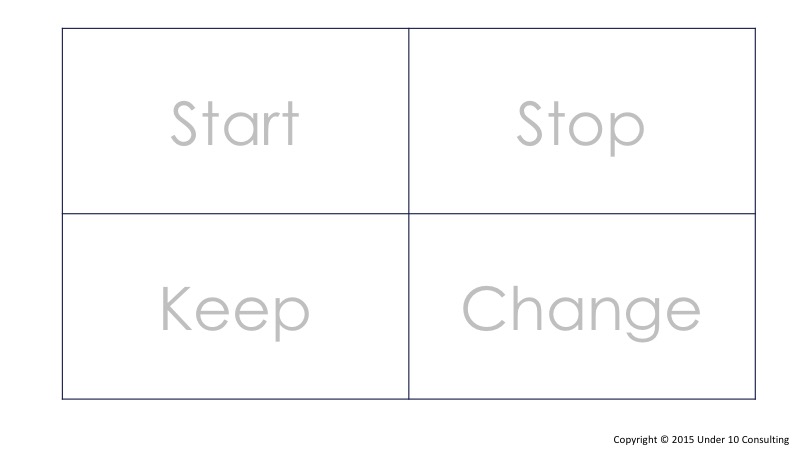Plan your next steps with a retrospective

The plans you make must be guided by your results from previous plans. After all, the best lens on the future is the past.
You made your plans with a set of assumptions: the size and skills of your product team, an expected rate of customer acquisition and retention, a level of funding for marketing and sales programs. Re-examine those assumptions and revise them based on your results. Look at what worked and what didn’t. Consider whether new methods can be applied to your products and services.
Make time for a retrospective.
A simple two-by-two is a powerful tool to help focus your thinking. Work with your colleagues to identify items to start, stop, keep, and change.

Keep
You’ve been doing some things right, of course. We definitely want to keep doing them in the new year. Look for some of the best techniques used by different teams and try to standardize them across all teams.
One product team adopted a quick prioritization approach for all new feature ideas to quickly determined if the ideas warranted further investigation. They examined value to the business, importance to the customer, dissatisfaction with the current solutions, and effort to deliver. In sharing this method, the other teams standardized on this simple approach.
Another team adopted the “Work at home on Thursday” idea and found great success from having uninterrupted time. They definitely want to keep doing this.
Don’t just look at your technical team but also things that you’re doing right in supporting sales and marketing folks, things you’re doing right when launching new functionality, and things you’re doing right in communicating to executives and clients.
Change
What should you change? What things have been ineffective? What are some areas you should revise your approach?
One team realized they were spending too much time estimating story points and changed to just counting stories instead. The team consistently delivered 4 to 6 stories a week. Some stories were small; some were large—but they averaged out over time. They also adopted the idea to reduce their work-in-progress to under 10 items. Would these changes work with your team?
Another firm did a few interviews with customers to learn about the product, its promotion, and how it was sold. They learned their customers’ decisions were tied directly to the effectiveness of the product demo. Unfortunately, some sales teams did a poor job while others put on elaborate shows that were very effective but also quite expensive. To make sure the product was shown in its best light, the firm developed a “Day at Corporate” program with a dedicated demo facility and staff.
Stop
What things should your team stop doing? For example, everyone is now agreed that multi-tasking doesn’t work; you just end up doing two things badly. Let’s stop this ineffective behavior!
One of my pet peeves is too many people at too many meetings. I went to a meeting once and saw one of my product managers there already. I said to the organizer, “You can only have one of us. Which of us is staying?” He said, “Well, we want Bruce because he knows stuff and we want you because you can make decisions.” I said, “Don’t worry; I’ll support Bruce’s decisions. I’m leaving.” And I walked out. How many meetings could you stop attending using this approach?
One company shared detailed product roadmaps with customers. Soon the customers were holding the company to the plan as a commitment. Solution: stop making printed copies available to sales people and customers.
Another company examined the costs and benefits of industry trade shows and decided to stop this wasteful spending. Research this: are you getting results from your shows or are you just wasting time and money?
Looking back, what “good ideas” from last year do you now realize weren’t so good? Printed roadmaps and too much specific information in terms of dates and features—for many firms, these are “worst” practices. Stop doing things that don’t work.
Start
You’ve been reading and listening and observing throughout the year. What new techniques have you discovered that you should start doing?
Some firms have started using a one-page product canvas as a replacement for traditional business cases. Many of my clients are now doing annual retrospectives on process, markets, and business goals. Some have started doing win loss analysis with the fine folks at Eigenworks. Would these ideas help your team?
It is always good to reflect on where you’ve been and where you’re going. It’s time to identify what to keep and change, what to start and what to stop.
Retrospectives encourage the good product management practice of refining process and plans to make success consistent and repeatable. What will you do in the new year to ensure continued success?
Retrospectives are a key part of your product playbook—a collection of workshops, tools, and templates to ensure your team is systematic in their methods and consistent in their deliverables.

